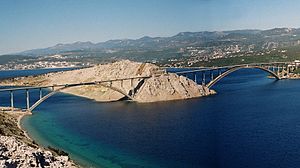Krk bridge
Coordinates: 45 ° 14 ′ 45 ″ N , 14 ° 34 ′ 8 ″ E
| Krk bridge | ||
|---|---|---|
| Official name | Krčki most | |
| use | Road bridge | |
| construction | Reinforced concrete arch bridge | |
| overall length | 1450 m | |
| width | 11.40 m | |
| Longest span | 390 m and 244 m | |
| Clear height | 67 m | |
| start of building | July 1976 | |
| opening | July 19, 1980 | |
| construction time | 4 years | |
| Status | has been renovated | |
| planner | Ilija Stojadinović | |
| toll | 39 kuna there and back (as of August 2018) | |
| location | ||
|
|
||
The Krk Bridge ( Croatian Krčki most ) connects the Croatian island of Krk with the mainland. It is part of the D102 , which branches off the D8 and connects the island with the mainland.
construction
The road bridge is an arch bridge made of reinforced concrete with an overhead roadway and consists of two bridges with the small island of Sveti Marko in the middle. The larger of the two bridges goes from the mainland over the Tihi canal ( German "(Wind-) Stiller Kanal" ) to Sveti Marko, the smaller from Sveti Marko over the Burni canal ( German : "Windiger Kanal" , named after the Bora ) to Krk. The spans are 390 m and 244 m. If you add the underwater foundations , the longer arch spans a width of 416 m. When it opened, it was the most widely spanned concrete arch bridge in the world and 85 m longer than the Gladesville Bridge near Sydney . It was only surpassed in 1996 by the Wanxiang Bridge in China with 420 m. Both bridges together with all access roads are 1,450 m long. The maximum arch height is 67 m.
The arches of the respective bridges were built from July 1976 to 1980 with prefabricated box segments in a free porch with an auxiliary guy. The two halves of the bridge approached each other from both sides and were finally connected in the middle. They are designed for wind speeds of 142 km / h. 20,500 m³ of concrete, 130 t of prestressing steel and 4,500 t of reinforcing steel were used. An average of 350 workers worked on the construction site.
The bridge was opened on July 19, 1980 under the name Tito Bridge . From 1980 to 2000, 27.2 million crossings were counted. Use of the bridge was subject to tolls until June 15, 2020.
New building
Recent studies show that storms and gusts of wind aren't the only threats to the bridge, salt is as well. The salt corrodes concrete and creates cracks. Due to unofficial data, z. B. the insufficient maintenance solution for so many repairs on the bridge caused damage. An expansion of the port terminal on Krk, as well as a larger volume of traffic, may make it necessary to build a new bridge and close the existing one. The new bridge would not be built on the site of the current one, but about 1,800 meters south of the Lanterna peninsula , which is the shortest distance to the mainland at just 600 meters. The new bridge would have four lanes and will have a direct connection to the A7 motorway .
literature
- BD Zakić: Theoretical and Experimental Analyzes of Test Results ot the Krk Bridge under Static and Dynamic Loads . In: Petar Miljanić (Ed.): Bulletin tome CXIII: Classe des sciences techniques, No 27 . Academie Serbe des Sciences et des Arts, Belgrade 1996, p. 35–52 ( full text in Google Book Search).
Web links
- Krk bridge in the bridge web
- Krk bridge. In: Structurae
- Plans and photos of the construction of the Krk Bridge, ETH Lausanne


